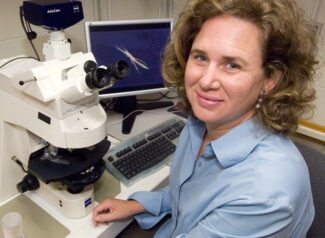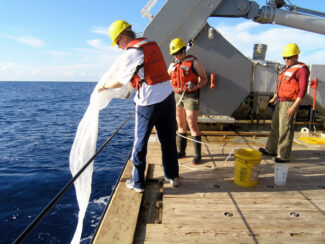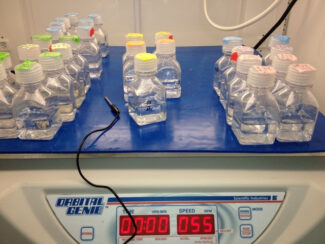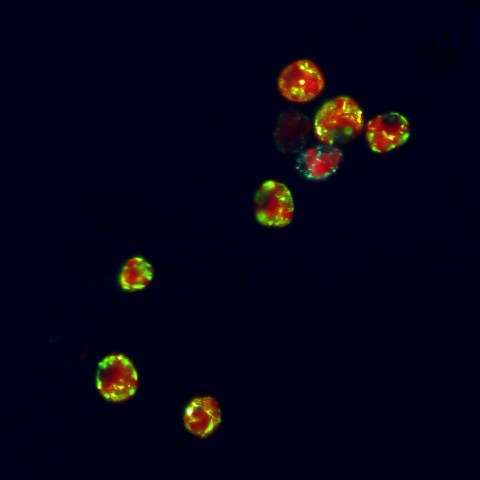How much carbon can the ocean absorb, and what happens to it as the planet warms? Sonya Dyhrman, a microbial oceanographer and professor at Lamont-Doherty Earth Observatory, is trying to answer these questions. (Lamont is part of the Columbia Climate School.)
Dyhrman studies marine microbes, which underpin the dynamics of the ocean’s highly complex ecosystem. “This amazingly complex network of interactions is really the heart of the ocean,” she says. “And it’s pivotal in answering the question of how much carbon the ocean can hold.” Dyhrman spoke to State of the Planet about how she conducts her research; learning about the chemical “language” of microorganisms; and why it’s important to teach young people ocean science.
What do you study and why is it important?

I study marine microbes, primarily photosynthetic marine microbes, which are the base of the marine food web and very important, not only for ecosystem dynamics in the ocean, but also for the cycling of carbon and other greenhouse gases. They play a pivotal role in terms of food chains and biogeochemistry.
The number one question I get is, what’s going to happen to the ocean in the future? We don’t yet understand the rules that allow us to predict who or what’s in the ocean and what they’re doing well enough to extrapolate about the future with the accuracy we want.
There is this amazingly complex web of interactions happening at an invisible microscopic scale. There’s a whole network of thousands and thousands of chemicals and microbes, and all of them have slightly different metabolic features. Some are photosynthetic. Some are predatory. Some live in symbiosis with each other. This network of interactions is really the heart of the ocean. It’s like this heartbeat that underpins every fish, whale, sea bird, seal and creature you care about. And when we ponder how much carbon the ocean can hold, and how well it will be able to buffer the changes we’re seeing in atmospheric carbon, that network is pivotal in answering the question.

How do you conduct your research?
Both the chemistry and ecosystem biology start with that heartbeat of chemicals and microbes all interacting with each other—but tracing those interactions when you can’t directly observe the microbes is really challenging. One of the exciting things that’s happened over the course of my career are the advances in technology. My work is centered on sequencing and genomics that has come out of things like the Human Genome Project. These [genomic] tools allow us to map out different regions of the ocean and say what species are there, and what their metabolic capabilities are.
What we do is twofold. We have isolates [a culture of microorganisms isolated for study] and microbes that we’ve gotten from seawater in different environments. We bring them back to the lab and do experiments on them in controlled conditions to try to understand how they work and how they respond to changes in their environment. We also take direct field observations and do experiments on the ships to find out what microbial organisms are there, what they are capable of and how they change under different conditions. The tools we use are called metagenomic because we’re looking at many different species all at one time. We take all the microbes, extract their DNA, sequence it and look at it using a supercomputer.
“This network of interactions is really the heart of the ocean. It’s like this heartbeat that underpins every fish, whale, sea bird, seal and creature you care about.”
How do you use these DNA sequences?
We can see which DNA matches different organisms, so we can say who’s there. I can also see that the DNA encodes different functions, so we can see what the organisms are capable of doing. We use tools called metatranscriptomics and metaproteomics. When the genes in the genome are turned on or transcribed into RNA, then that RNA can make a protein, which basically does the work of the cell. [With these tools] we can map out which genes are turned on and which genes are turned off under different conditions in different components of the population.
It’s almost magical that we can do this. Early in my career, we would bring a microbe into culture and painstakingly try to look at maybe one gene instead of a whole genome or one protein. Now we can look at 10,000 from one sample!
What have some of your findings revealed?
We’ve developed a model with a photosynthetic nitrogen-fixing cyanobacteria [a blue-algae that uses sunlight to make nitrogen], which plays a keystone role in the low-resource environments where it lives. We thought that predicting its activities was just a matter of its interaction with the chemical network, but we learned that the activities of that organism also depend on those of the organisms growing on and around it. Basically, these organisms are talking to each other with a chemical language. Understanding that was a key ‘aha’ moment for me.
We also did a large collaborative study to understand part of the work going on at Station ALOHA, about 200 miles off Hawaii. Every day the sun comes up and there is a new pulse of carbon dioxide that is fixed in the ocean by the photosynthetic organisms, which then reverberates through the community. To understand what happens over the course of a day as all these microbes interact with their environment and with each other, we had two ships’ worth of scientists out doing sampling over day and night cycles in this region for several weeks.
In a paper that came out of that work, we were able to show how the organisms move this carbon when there are limiting resources such as nitrogen. We could see that different groups of organisms partitioned using their nitrogen different times over the course of a day. The initial carbon fixation is really tied to the sun coming up. We could see that carbon metabolism works its way through the different organisms, and we saw them then taking turns with the nitrogen. Being able to put together those carbon-nitrogen dynamics over the course of a day was really exciting and helps us understand how this system is operating.

How are you going to connect the very specific research you’re doing to your larger goal of understanding how ocean dynamics work?
Several of my projects are part of larger collaborative studies, where we have everyone from chemists measuring the chemicals in that network—people like me looking at who’s there and what they’re doing—and then also modelers who think about how this interaction might influence the carbon cycle, and how we might project that into different environments or into the future.
From the research you’ve done so far, do you have a sense about the future fate of the ocean?
As the ocean warms and becomes more acidic, it changes other resources. This is where trying to understand the future is really challenging, because we’re still trying to work out the rules of the present. My colleagues have modeled that changes in temperature will shift community dynamics and which organisms exist across latitudes. It might also change how that network is operating by changing the resources that are available. The microbes will be okay, but they may not be the same species or do the same things that we depend on. We are trying to understand what the sensitivities and rules are, so we can start asking questions about the sensitivity of those rules to potential changes. The more we understand the basic rules, the better off we’re going to be in terms of thinking about a sustainable future and about how fisheries, biology, chemistry, etc., might be influenced.
The ocean microbe network plays a vital role in how the ocean functions, which literally makes our planet habitable—the cyanobacteria in the ocean produced the oxygen that oxygenated our atmosphere. So what’s happening with the microbes in the ocean is important to what happens for our planet.
Do you think enough people understand how important the ocean is?
I think it’s essential to share that message in our educational systems, and I think it needs to start at a younger age. We don’t teach ocean science in core STEM curricula or in our country’s state science standards. By not making it part of the curriculum, we miss an opportunity to share the message about the important role that the ocean and its microbes play in how our planet works. I have a passion for trying to find ways to expand that.
Source link
Renée Cho news.climate.columbia.edu

